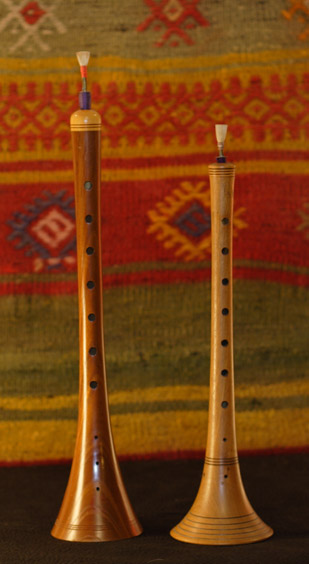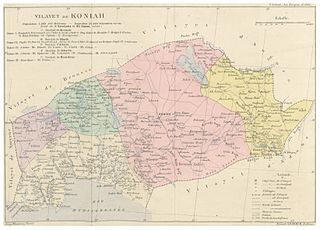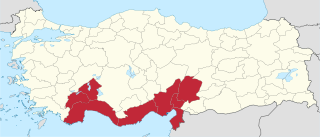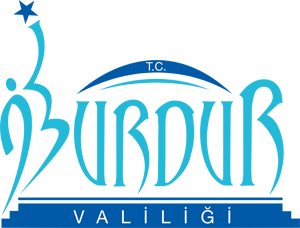This article needs additional citations for verification .(January 2017) |
| External video | |
|---|---|

Teke zortlatmasi is a Turkish dance, with origins in Burdur, Isparta, Antalya, Denizli and Fethiye (Teke Region).[ citation needed ] The meter is 9/16. [1]
This article needs additional citations for verification .(January 2017) |
| External video | |
|---|---|

Teke zortlatmasi is a Turkish dance, with origins in Burdur, Isparta, Antalya, Denizli and Fethiye (Teke Region).[ citation needed ] The meter is 9/16. [1]

Burdur Province is a province of Turkey, located in the southwest and bordering Muğla and Antalya to the south, Denizli to the west, Afyon to the north, and Isparta to the east. It has an area of 6,887 km2 and a population of 273,799 (2022). The provincial capital is Burdur city.

The Teke people or Bateke, also known as the Tyo or Tio, are a Bantu Central African ethnic group that speak the Teke languages and that mainly inhabit the south, north, and center of the Republic of the Congo, the west of the Democratic Republic of the Congo, with a minority in the south-east of Gabon. Omar Bongo, who was President of Gabon in the late 20th century, was a Teke.

Turkish folk music is the traditional music of Turkish people living in Turkey influenced by the cultures of Anatolia and former territories in Europe and Asia. Its unique structure includes regional differences under one umbrella. It includes popular music from the Ottoman Empire era. After the foundation of the Turkish Republic in 1923, Turkish President Mustafa Kemal Atatürk ordered a wide-scale classification and archiving of samples of Turkish folk music from around the country, which, from 1924 to 1953 collected around 10,000 folk songs. Traditional folk music was combined with Western harmony and musical notation to create a more modern style of popular Turkish music.

Burdur is a city in southwestern Turkey. The seat of Burdur Province and of Burdur District, it is located on the shore of Lake Burdur. Its population is 95,436 (2021).

Zeybeks, sometimes spelled as Zeibeks, were irregular militia and guerrilla fighters living in West Anatolia from late 17th to early 20th centuries.

Turkish folk dances are the folk dances of Turkey. Facing three seas, straddling important trade routes, Turkey has a complex, sophisticated culture, reflected in the variety of its dances. The dominant dance forms are types of line dance. There are many different types of folk dances performed in various ways in Turkey. Zeybek, Teke Zortlatması in Aegean region, Bar in Erzurum province, Halay in the central, southern, eastern, and southeastern parts of the country, Hora in Thrace, Horon in the eastern Black Sea region, Spoon dances in and around Konya, and Lezginka in Kars and Ardahan are some of the best known examples of these.

The Vilayet of Konya was a first-level administrative division (vilayet) of the Ottoman Empire in Asia Minor which included the whole, or parts of, the ancient regions of Pamphylia, Pisidia, Phrygia, Lycaonia, Cilicia and Cappadocia.

The zeybek is a form of Turkish folk dance originating from Yörüks particular to Western, Central and Southern Anatolia in Turkey. It is named after the Zeybeks.

Shish kofta (Turkish) is a type of kebab-style kofta dish in Turkish cuisine.

Lake Burdur is a large saline lake of tectonic origin, positioned at the frontier between Burdur and Isparta provinces in southwestern Turkey. It has an area of 250 km2 and a maximum depth variously reported at between 50 and 110 m. The water level in the lake fluctuates. Lake Burdur is also an important wetland site for many bird species and is designated a Ramsar site.

The Mediterranean Region is a geographical region of Turkey. The largest city in the region is Antalya. Other big cities are Adana, Mersin and Kahramanmaraş.
The 1914 Burdur earthquake occurred at 00:07 local time on 4 October. It was estimated to be 7.0 on the surface wave magnitude scale with a maximum intensity of IX (Violent) on the Mercalli intensity scale. It was centered near Lake Burdur in southwestern Anatolia and the mainshock and subsequent fire destroyed more than 17,000 homes, and caused 2,344 casualties.

Burdur Mehmet Akif Ersoy University, abbreviated as MAKU, is a public university located in Burdur, Turkey. It was established in 2006. It is named after Mehmet Akif Ersoy.
Temuraga ,Tamour agha, is a form of the Anatolian folk dance bar (dance) or Kasik Havasi.Temuraga is a folk dance spread all over Eastern Anatolia Region. There are similar folkloric dance tunes known as Çek deveci develeri engine in the Burdur.

The Mediterranean Region (TR6) is a statistical region in Turkey.

The Governor of Burdur is the bureaucratic state official responsible for both national government and state affairs in the Province of Burdur. Similar to the Governors of the 80 other Provinces of Turkey, the Governor of Burdur is appointed by the Government of Turkey and is responsible for the implementation of government legislation within Burdur. The Governor is also the most senior commander of both the Burdur provincial police force and the Burdur Gendarmerie.
İnsuyu Cave is a show cave situated near Burdur in southwestern Turkey. Being over 500 m (1,600 ft) in length, it was discovered in 1952 and opened to public in 1965. A second cave beyond the show cave was later discovered. The lakes inside the both caves are in danger of drying due to excessive drilling of wells in the valley above. However, efforts are underway to reverse the process.
Lake Yarışlı is a lake in Turkey.
Lake Karataş, also known as Lake Bahçeözü, is a fresh water lake in Burdur Province, Turkey.

Teke Peninsula, also known as Teke Region, is a peninsula located in southwestern Turkey between the gulfs of Antalya and Fethiye extending into the Mediterranean Sea. It is bordered to the Turkish Lakes Region in the north.